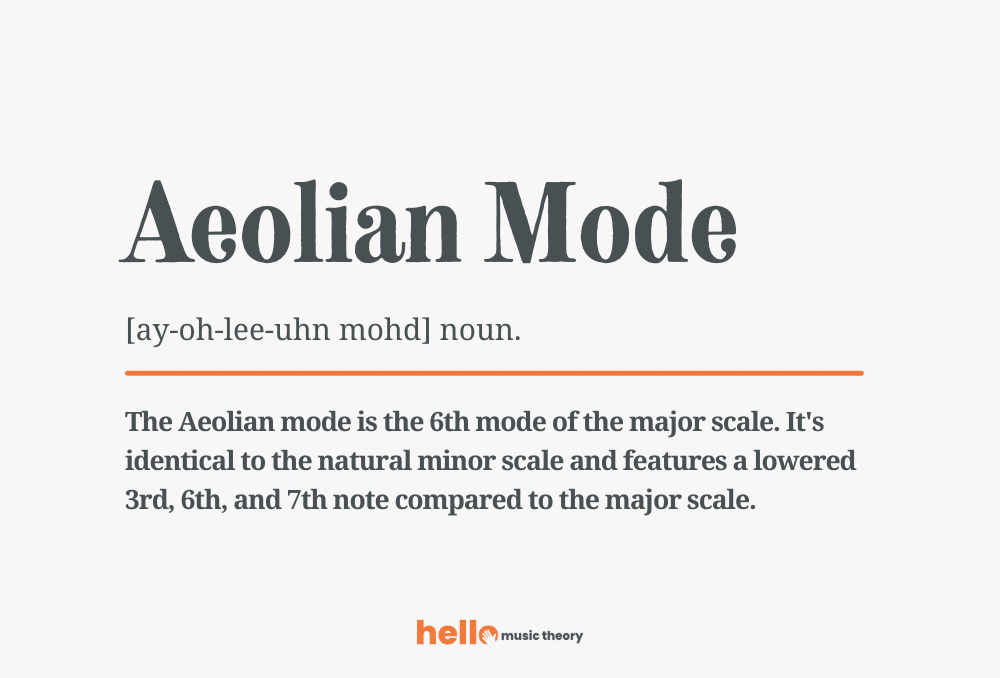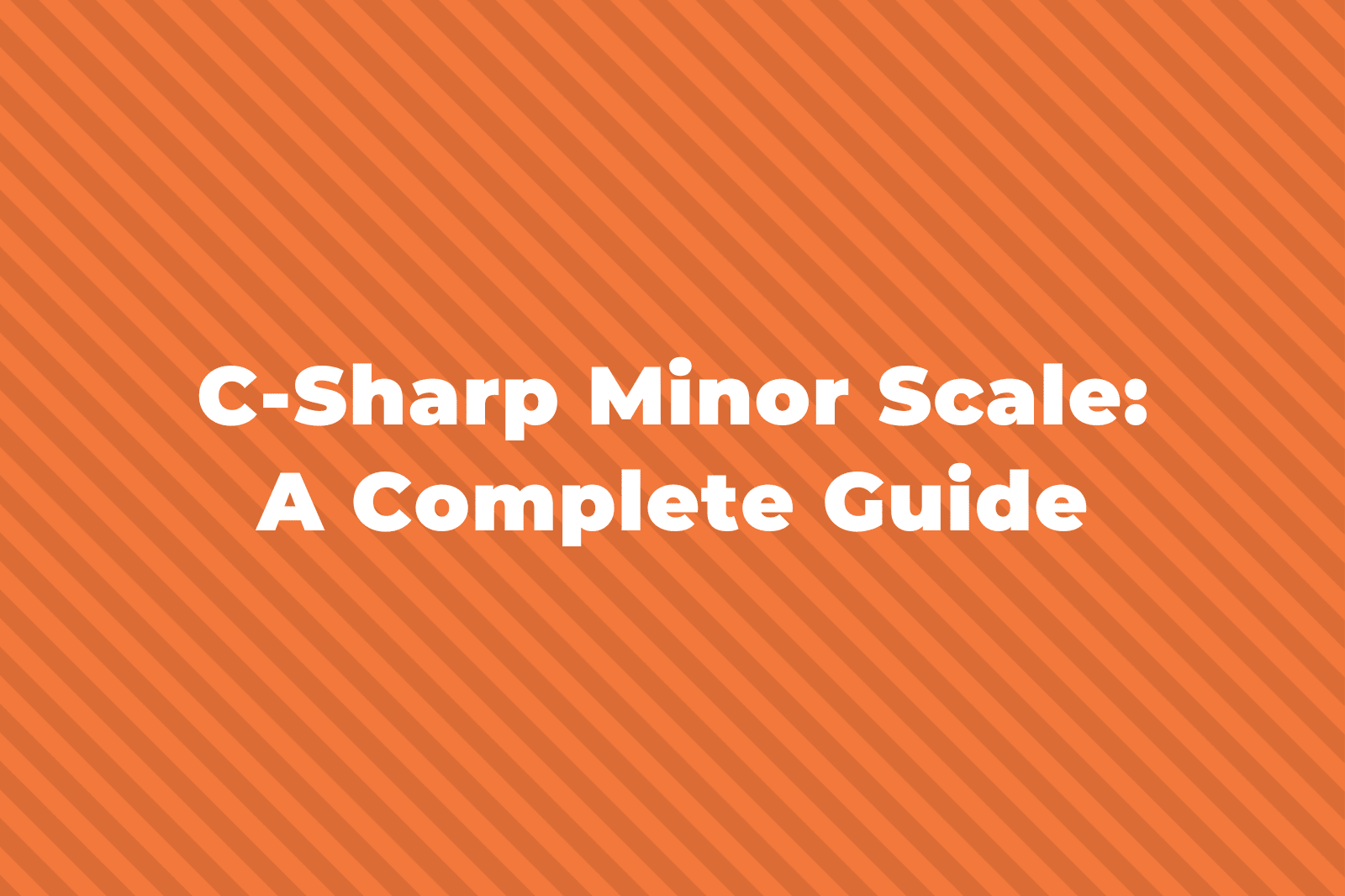The Aeolian mode is the second most popular mode, only behind the Ionian mode. It is most likely the second scale people learn when starting to play an instrument and is the second most used mode in classical music and modern pop music.
This post will explore everything about the Aeolian mode, what it is, and how it is played. But first, let’s recap the basics: What are modes?
What is the Aeolian Mode?

The Aeolian mode is the 6th mode of the major scale. It’s identical to the natural minor scale and features a lowered 3rd, 6th, and 7th note compared to the major scale.
For example, C Aeolian contains the notes: C – D – Eb – F – G – Ab – Bb.

This mode has a somber and contemplative sound, often associated with a melancholic or introspective mood.
The Aeolian mode uses this formula of half and whole steps (semitones and tones) to form its scale: W – H – W – W – H – W – W
Or using semitones and tones: T – S – T – T – S – T – T
What Are The Modes?
In music, a mode is essentially a scale, much like scales you’ve most likely seen before like major and minor scales).
What makes modes (also called church modes or Greek modes) unique is their relationship to each other.
There are seven different modes, each made by playing a major scale starting on a different note.
Take C major scale, for example, made up of the notes: C, D, E, F, G, A, B, C.
If you were to play these notes in order, but starting on F (F, G, A, B, C, D, E, F), you would actually be playing the scale of the F Lydian mode.
Or, if you start on E, you’re playing in the E Phrygian mode.
There are seven different modes of the major scale because you can start the scale on seven different notes.
| Modal scales | Notes of the mode |
| C Ionian mode | C – D – E – F – G – A – B |
| D Dorian mode | D – E – F – G – A – B – C |
| E Phrygian mode | E – F – G – A – B – C – D |
| F Lydian mode | F – G – A – B – C – D – E |
| G Mixolydian mode | G – A – B – C – D – E – F |
| A Aeolian mode | A – B – C – D – E – F – G |
| B Locrian mode | B – C – D – E – F – G – A |
Degrees of the Aeolian Scale
The Aeolian mode is a minor mode, which means the 3rd scale degree is lowered by a half step (from the major scale) to become a minor 3rd.
This scale is almost the same as the one for the Dorian mode, except it also has a minor (lowered) 6th.
- 1. Root
- 2. Major second
- 3. Minor third
- 4. Perfect fourth
- 5. Perfect fifth
- 6. Minor sixth
- 7. Minor seventh

The Aeolian mode is heard almost whenever you hear music in the minor key.
Because of this, it is also considered sad and serious as it has an extra minor note in its scale. It sounds darker and more minor than the Dorian mode, the other popular minor mode.
Music Written in the Aeolian mode
As we’ve said before, ‘almost’ any time you hear music in a minor key, you are probably hearing the Aeolian mode.
It is found a lot in pop music, like the songs “Hello” by Adele (which is in F Aeolian) and “Somebody That I Used To Know” by Gotye (which is in D Aeolian).
It is also found in rock music, like the songs “All Along the Watchtower” by Bob Dylan and “Losing My Religion” by R.E.M., both in A Aeolian.
It is also found in classical music, for example, the opening to Beethoven’s famous “Moonlight Sonata,” which is in C# Aeolian.
Check out our post here for more songs in the Aeolian mode.
List of the Aeolian Modes
Here is a list of all of the Aeolian modes, starting on each note.
| Key | Notes in the Aeolian mode |
| C | C – D – Eb – F – G – Ab – Bb – C |
| C♯ | C# – D# – E – F# – G# – A – B – C# |
| Db | Db – Eb – Fb – Gb – Ab – Bbb – Cb – Db |
| D | D – E – F – G – A – Bb – C – D |
| D# | D# – E# – F# – G# – A# – B – C# – D# |
| Eb | Eb – F – Gb – Ab – Bb – Cb – Db – Eb |
| E | E – F# – G – A – B – C – D – E |
| F | F – G – Ab – Bb – C – Db – Eb – F |
| F# | F# – G# – A – B – C# – D – E – F# |
| Gb | Gb – Ab – Bbb – Cb – Db – Ebb – Fb – Gb |
| G | G – A – Bb – C – D – Eb – F – G |
| G# | G# – A# – B – C# – D# – E – F# – G# |
| Ab | Ab – Bb – Cb – Db – Eb – Fb – Gb – Ab |
| A | A – B – C – D – E – F – G – A |
| A# | A# – B# – C# – D# – E# – F# – G# – A# |
| Bb | Bb – C – Db – Eb – F – Gb – Ab – Bb |
| B | B – C# – D – E – F# – G – A – B |
Summing up the Aeolian Mode
To recap, the Aeolian mode is found whenever you see the natural minor scale.
It forms the basis of a lot of the music you hear today. To get a good sense of how it sounds and makes you feel, try playing the white notes on a piano from A to A.
We hope this post has helped you learn more about it, and let us know if you have any questions.



